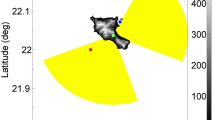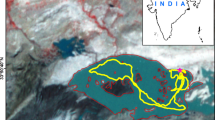Abstract
This work intends to determine if low-cost surveying techniques based on recreational echosounders can be used to perform nearshore bathymetry for analysing evolution of coastal sectors. For that purpose, two hydrographic surveying techniques were compared, i.e. (1) a real-time kinematic differential global positioning system (RTK-DGPS) synchronised with a single beam echosounder with real-time tidal elevation correction and (2) a low-cost recreational echosounder-chartplotter system using Global Navigation Satellite Systems (GNSS) with real-time European Geostationary Navigation Overlay Service (EGNOS) augmentation services and depth values post-processed using measured sea level. Two bathymetric data sets were obtained, one by each method, for the same area and survey lines at an ebb tidal delta (Tavira Inlet, Ria Formosa Portugal). Vertical differences were determined assuming no morphological variations between surveys. Results showed that depth elevation differences between bathymetric surfaces were of 0.10 ± 0.16 m, slightly higher but within the same order of the error attributable to the used interpolator (0.00 ± 0.11 m, triangular surface fitting). The differences between surveys performed with two different equipment sets and using different methodologies for correcting water elevations are very small both quantitative and qualitatively. Those differences can be diminished by improving the tidal level correction and uncertainties associated to different tidal slopes throughout the survey area. Pitch/roll corrections performed with low-cost GPS receivers would be also a valuable addition to the accuracy and precision of the method. It is then concluded that navigation with EGNOS augmentation services and sounding devices ten times cheaper than combined RTK-DGPS with single beam echosounders allow to measure and monitor accurately the nearshore bathymetry.








Similar content being viewed by others
References
Aarninkhof SGJ, Ruessink BG, Roelvink JA (2005) Nearshore subtidal bathymetry from time-exposure images. J Geophys Res 110, C06011
Andrade CF (1990) O Ambiente Barreira da Ria Formosa, Algarve-Portugal. PhD Thesis, Universidade de Lisboa. 627 pp. (in Portuguese)
Baptista P, Cunha TR, Matias A, Gama C, Bernardes C, Ferreira Ó (2011) New land-based method for surveying sandy shores and extracting DEMs: the INSHORE system. Environ Monit Assess 182(1):243–257
Bell PS, Osler JC (2011) Mapping bathymetry using X-band marine radar data recorded from a moving vessel. Ocean Dyn 61(12):2141–2156
Brando V, Anstee JM, Wettle M, Dekker AG, Phinn SR, Roelsema C (2009) A physical based retrieval and quality assessment of bathymetry from suboptimal hyperspectral data. Remote Sens Environ 113:655–690
Costa M, Silva R, Vitorino J (2001) Contribuição para o estudo do clima de agitação marítima na costa Portuguesa. 2as Jornadas Portuguesas de Engenharia Costeira e Portuária in CD-ROM. (in Portuguese)
Danson E, Kingdom U (2006) Understanding LiDAR bathymetry for shallow waters and coastal mapping. TS 19 Hydrography II:1–6
EGNOS (2009) EGNOS service definition document—open service, version 1.0 (EGN-SDD OS V1.0). European Commission, Directorate-General for Energy and Transport, 62pp
Felski A, Nowak A, Woźniak T (2011) Accuracy and availability of EGNOS—results of observations. Artif Satell 46(3):111–118
Hicks DM, Hume TM (1997) Determining sand volumes and bathymetric change on an ebb-tidal delta. J Coast Res 13(2):407–416
Holman RA, Holland KT, Lalejini DM, Spansel SD (2011) Surf zone characterization from unmanned aerial vehicle imagery. Ocean Dyn 61(11):1927–1935
Holman R, Plant N, Holland T (2013) cBathy: a robust algorithm for estimating nearshore bathymetry. J Geophys Res Oceans 118:2595, 609
Johnston S (2003) Uncertainty in bathymetric surveys. Coast Eng Tech Note IV–59 22 pp
Mobley CD, Sundman LK, Davis CO, Downes TV, Leathers RA, Montes MJ, Bissett WP, Kohler DD, Reid RP, Louchard EM, Gleason A (2005) Interpretation of hyperspectral remote-sensing imagery via spectrum matching and look-up tables. Appl Opt 44:3576–3592
Pacheco A, Vila-Concejo A, Ferreira Ó, Dias JA (2008) Assessment of tidal inlet evolution and stability using sediment budget computations and hydraulic parameter analysis. Mar Geol 247(1–2):104–127
Pacheco A, Ferreira Ó, Williams JJ, Garel E, Vila-Concejo A, Dias JA (2010) Hydrodynamics and equilibrium of a multiple inlet system. Mar Geol 274:32–42
Pacheco A, Williams JJ, Ferreira Ó, Garel E, Reynolds S (2011) Application of sediment transport models to a multiple-inlet system. Estuar Coast Shelf Sci 95:119–134
Sanders P (2003) RTK tide basics. Hydrol Int 2003:26–29
Stauble D (1998) Techniques for measuring and analysing inlet ebb shoal evolution. Coast Eng Tech Note IV–13 12 pp
Surfer 9.0 Manual (2009) Contouring and 3D surface mapping for scientists and engineers. Golden Software, Inc. 56 pp
Van Dongeren A, Plant NG, Cohen A, Roelvink D, Haller MC, Catalan P (2008) Beach Wizard: nearshore bathymetry estimations through assimilation of model computations and remote observations. Coast Eng 55:1016–1027
Acknowledgment
This paper is a contribution to the project EROS – Erosion of Rocky Shores – differences in protection promoted by sandy beaches and shore platforms (FCT–PTDC/CTE-GIX/111230/2009) and project MOSES - Moving Sands - Equilibrium State of Crenulated Coasts (PTDC/GEO-GEO/3981/2012) funded by the Portuguese Foundation for Science and Technology. André Pacheco was supported Portuguese Foundation for Science and Technology grant number SFRH/BPD/76110/2011. The authors would like to acknowledge the contribution of João Salvé-Rainha for logistical support during data acquisition. We also greatly acknowledge the contribution of the reviewers that greatly contributed to improve early versions of this work, particularly to Edwin Danson.
Author information
Authors and Affiliations
Corresponding author
Additional information
Responsible Editor: Birgit Andrea Klein
Rights and permissions
About this article
Cite this article
Horta, J., Pacheco, A., Moura, D. et al. Can recreational echosounder-chartplotter systems be used to perform accurate nearshore bathymetric surveys?. Ocean Dynamics 64, 1555–1567 (2014). https://doi.org/10.1007/s10236-014-0773-y
Received:
Accepted:
Published:
Issue Date:
DOI: https://doi.org/10.1007/s10236-014-0773-y




